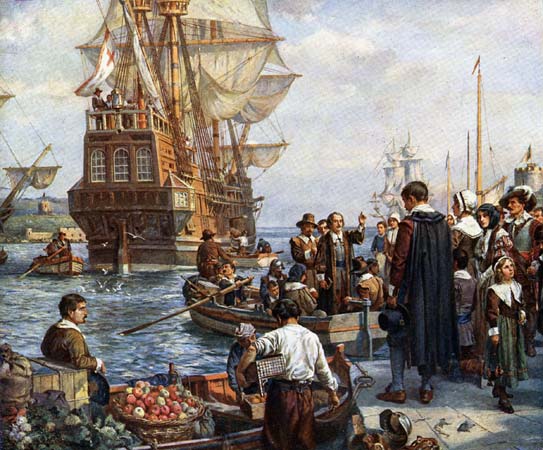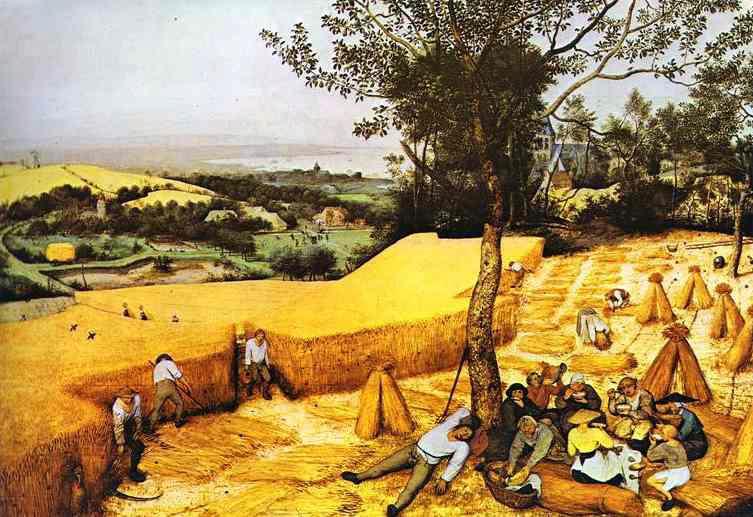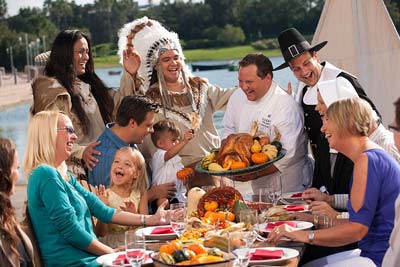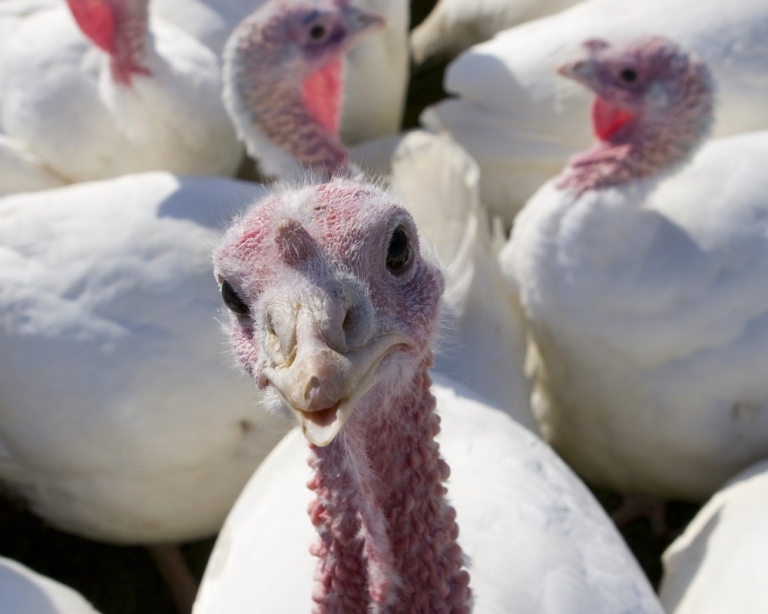Throughout history mankind has celebrated the bountiful harvest with thanksgiving ceremonies. Before the establishment of formal religions many ancient farmers believed that their crops contained spirits which caused the crops to grow and die.
Many believed that these spirits would be released when the crops were harvested and they had to be destroyed or they would take revenge on the farmers who harvested them. Some of the harvest festivals celebrated the defeat of these spirits. Harvest festivals and thanksgiving celebrations were held by the ancient Greeks, the Romans, the Hebrews, the Chinese, and the Egyptians.

In 1609, a group of Pilgrims left England to flee the religious prosecutions and went to Holland where they lived and prospered. After a few years their children were speaking Dutch and had become attached to the dutch way of life. This worried the pilgrims. They considered the Dutch frivolous and their ideas a threat to their children's education and morality.So they decided to leave Holland and travel to the New World. Their trip was financed by a group of English investors, the Merchant Adventurers. It was agreed that the Pilgrims would be given passage and supplies in exchange for their working for their backers for 7 years.
On September 6th, 1620 the Pilgrims set sail for the New World on a ship called the Mayflower. They sailed from Plymouth, England and aboard were 44 Pilgrims, who called themselves the "Saints", and 66 others, whom the Pilgrims called the "strangers".The long trip was cold and damp and took 65 days. Since there was a danger of fire on the wooden ship, the food had to be eaten cold. Many passengers became sick and one person died by the time land was sighted on November 10th.
The long trip led to many disagreements between the "Saints" and the "Strangers". After land was sighted a meeting was held and an agreement was worked out, called the Mayflower Compact, which guaranteed equality and unified the two groups. They joined together and named themselves the "Pilgrims".
The long trip led to many disagreements between the "Saints" and the "Strangers". After land was sighted a meeting was held and an agreement was worked out, called the Mayflower Compact, which guaranteed equality and unified the two groups. They joined together and named themselves the "Pilgrims".
Although they had first sighted land off Cape Cod, they did not settle until they arrived at Plymouth. It was there that the Pilgrims decided to settle. Plymouth offered an excellent harbour. A large brook offered a resource for fish. The pilgrims biggest concern was the local Native American Indians. But the Patuxets were a peaceful group and did not prove to be a threat.The first winter was devastating to the Pilgrims. The cold, snow and sleet was exceptionally heavy, interfering with the workers as they tried to construct their settlement. March brought warmer weather and the health of the Pilgrims improved, but many had died during the long winter. Of the 110 Pilgrims and crew who left, less than 50 survived the first winter.
On March 16, 1621,what was to become an important event took place, an Indian brave walked into the Plymouth settlement. The Pilgrims were frightened until the Indian called out "Welcome" (in English). His name was Samoset and he was an Abnaki Indian. He had learnt English from the captains of fishing boats that had sailed off the coast. After staying the night Samoset left the next day. He soon returned with another Indian named Squanto who spoke better English than Samoset. Squanto told the Pilgrims of his voyages across the ocean and his visits to England and Spain. It was in England that he had learnt English.
Squanto's importance to the Pilgrims was enormous and it can be said that they would not have survived without his help. It was Squanto who taught the Pilgrims how to tap the maple trees for sap. He taught them which plants were poisonous and which had medicinal powers. He taught them how to plant the Indian corn by heaping the earth into low mounds with several seeds and fish in each mound. The decaying fish fertilized the corn. He also taught them how to plant other crops with the corn.
The harvest in October was very successful and the Pilgrims found themselves with enough food to put away for the winter. There was corn, fruits and vegetables, fish to be packed in salt, and meat to be curved over smoky fires. The Pilgrims had much to celebrate, they had built homes in the wilderness, they had raised enough crops to keep them alive during the long coming winter, they were at peace with their indian neighbours.

The Pilgrim Governor William Bradford proclaimed a day of thanksgiving to be shared by all colonists and the neighbouring Native Americans. They invited Squanto and the other Indians to join them in their celebration. Their chief, Massasoit, and 90 braves came to the celebration which lasted for 3 days. They played games, ran races, marched and played drums. The Indians demonstrated their skills with the bow and arrow and the Pilgrims demonstrated their musket skills.It is believed that the celebration took place in mid-October.
The following year the Pilgrims harvest was not as bountiful as they were still unused to growing the corn. During the year they also had to share their stored food with newcomers and the Pilgrims ran short of food.The 3rd year brought a spring and summer that was hot and dry with the crops dying in the fields. Governor Bradford ordered a day of prayer, and soon thereafter the rain came. To celebrate – November 29th of that year was proclaimed a day of thanksgiving. This date is believed to be the real true beginning of the present day Thanksgiving Day.

The custom of an annually celebrated thanksgiving, held after the harvest, continued through the years. In 1817 New York State had adopted Thanksgiving Day as an annual custom. By the middle of the 19th century many other states also celebrated a Thanksgiving Day. In 1863, President Abraham Lincoln appointed a national day of thanksgiving. Since then each president has issued a Thanksgiving Day proclamation, usually designating the fourth Thursday of each November as the holiday.
Thanksgiving in Canada is celebrated on the second Monday in October. Observance of the day began in 1879.
THE THANKSGIVING TURKEY
Of all the thanksgiving symbols the Turkey has become the most well known. The wild turkey is native to Northern Mexico and the Eastern United States. The turkey has brown features with buff-coloured feathers on the tips of the wing and on the tail.The male turkey is called a Tom and, as with most birds, is bigger and has brighter and more colourful plumage. The female is called a Hen and is generally smaller and drab in colour.
The Turkey was originally domesticated in Mexico, and was brought into Europe early in the 16th century. Since that time, turkeys have been extensively raised because of the excellent quality of their meat and eggs.
Though there is no real evidence that turkey was served at the Pilgrim's first thanksgiving, in a book written by the Pilgrim's Governor Bradford, he does make mention of wild turkeys. In a letter sent to England, another Pilgrim describes how the governor sent "four men out fowling" returning with turkeys, ducks and geese.





